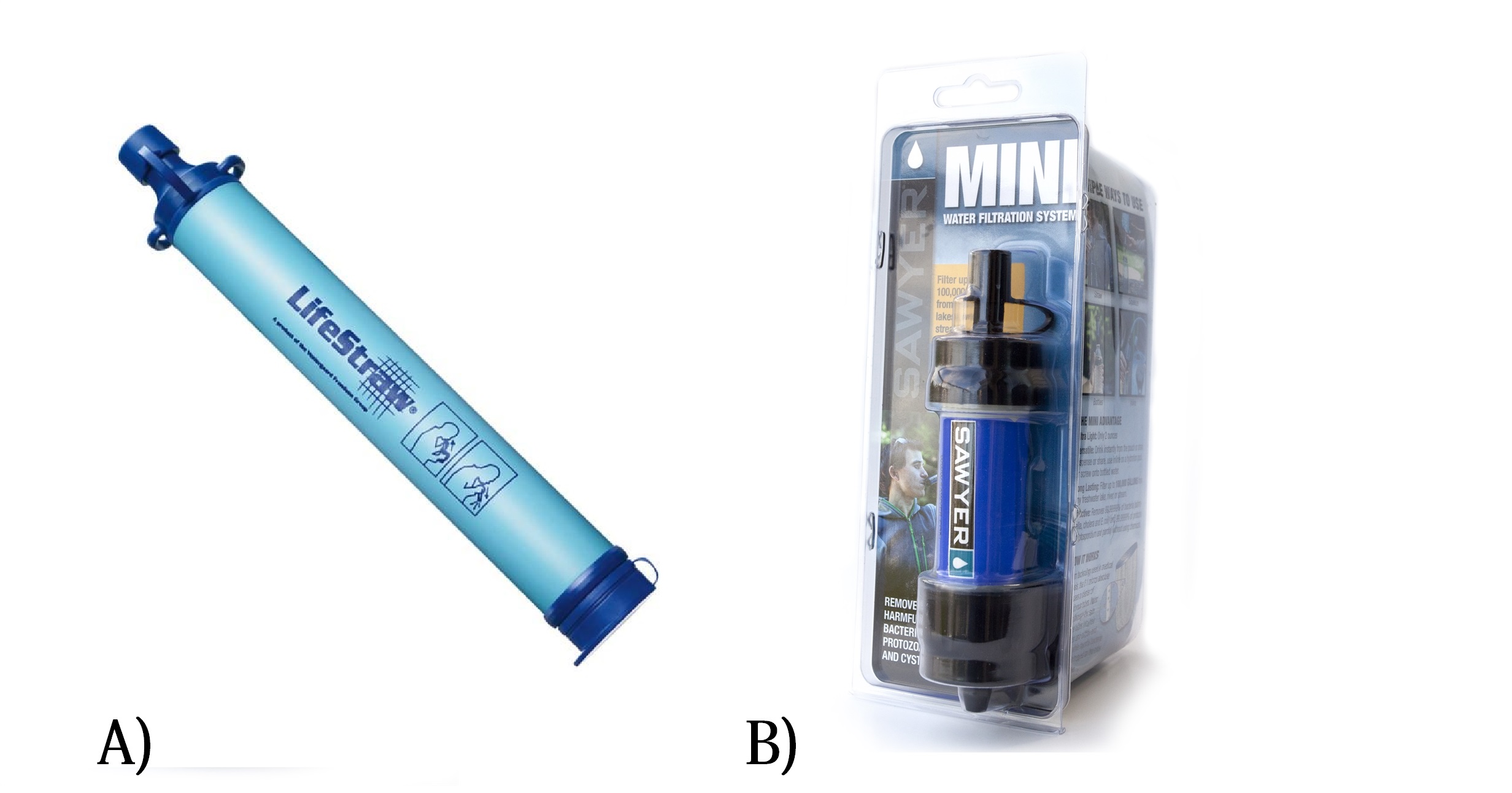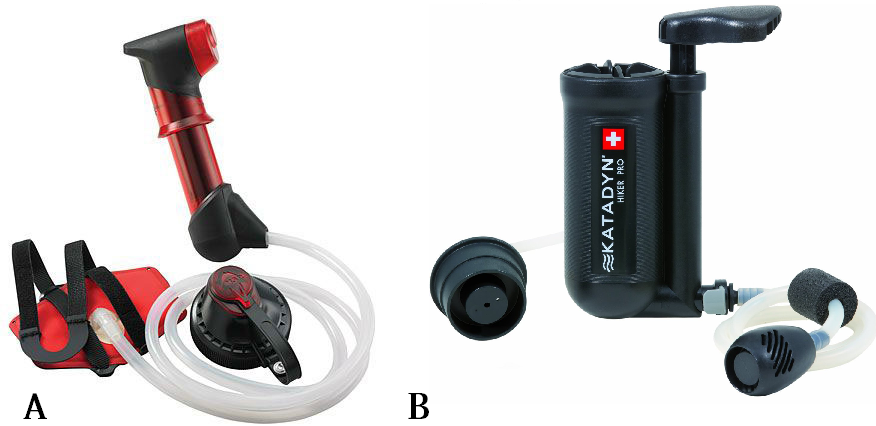In this comprehensive article we will be discussing the top lightweight methods for water treatment while traveling solo or in a group through the back country. After reading this article you will be familiar with many of the popular methods of water treatment including pump filters, point-of-use filters, gravity filters, chemical treatments, ultraviolet light, and boiling. For an overview of conclusions made for each system, scroll down to the bottom of the article.
When weight is a concern it is important to consider different treatment methods and understand the advantages and drawback of each system. The options listed may be up for debate, personal preference, and depend upon the specific requirements for particular trips.
Solo Travel

The following are the top two lightweight options for water treatments while traveling solo in the back country.All treatment systems discussed have the opportunity to weigh less than 4oz dependent upon the amount of water needed to be treated during a given trip.
Ultra Violet Light
Ultra Violet Light is a micro-organism killer. It has a wave length so short that it is able to destroy the nucleic acids in organisms scrambling their DNA so that they can no longer perform vital cellular functions, like reproducing. This James Bond method of water treatment is now available for outdoor enthusiast.

One of the most popular UV Light products for water treatment is the SteriPen. SteriPen has several different product models weighing under 4ozs with differences between weight, battery, longevity, display, and size. Other popular and great options are offered by Camelback and Meridian Designs.
Advantages:
-It‘s very quick. One liter of water can be treated in only 45-60 seconds.
-It’s very light weight. At under 4ozs its is considerably lighter than many other options
-It’s doesn’t clog up. Pumps and other filtration systems run the risk of building up sediment.
Disadvantages:
-It’s an electronic. It needs to use batteries or be charged and it can malfunction. Carrying a back-up treatment is generally recommended.
-It’s expensive. Most units cost within the hundred dollar range.
-Limited effectiveness in stagnant water. When water is cloudy and full of debris dangerous micro-organisms may be able to find shelter from the UV light leaving their cellular functions intact.
-May not filter debris or pollution from the water source.
Survival Fact:
Did you know that water can be treated by the sun? UV Light naturally passing through our atmosphere can kill the micro-organisms in your water.
The drawback, it takes very long! It is said that a clear plastic water bottle with one liter of water can take over 6 hours to be treated in direct sunlight.
Chemical Treatments (Iodine and Chlorine Dioxide):
Many chemical treatments come in liquid and tablet form. They are general dropped in dirty water containers and take 20-30 minutes to treat one liter of water.
There are two popular chemical treatments available, iodine and chlorine dioxide.
The once popular iodine water treatments may have started to go out of favor with outdoor enthusiasts. Iodine, even with taste enhancing treatments, carries an unpleasant flavor that may detract from the connection of the natural source that water is pulled from.
There are some differences between the two chemicals. Iodine may not treat water for viruses but chlorine will. Both will treat water of from giardia, a dangerous protozoan parasite, but iodine may not treat water from cryptosporidiosis which causes diarrhea.

Advantages:
-It’s light weight. You can carry what you need.
Disadvantages:
-May change the taste of the water, detracting from the connection from the natural source.
-Longer treatment times than UV light.
-Doesn’t filter debris or pollution from the water source.
Other considerations
The following are the top lightweight water treatments for solo travel, but what about the other options? Why wasn’t boiling water discussed? What about pump filters?
Great questions, let us discuss these other options.

Boiling water: Boiling water is a great light weight option for treating water in the back country. Creating a fire off natural fuel can be one of the lightest options for treating water. However, when the decision is made to carry fuel only to boil water in order to treat it, boiling becomes out of favor. The amount of fuel required to boil a sizable amount of water out-weighs the other suggested options.
Pump Filters: Are you trying to get water from a very small source? Is the water you need to treat stagnant? Pump filters may be the best option in these cases. Pump Filters weight ranges from 7oz and up and can help mitigate these problems in your solo travels.

Point-Of-Use Filters: Many point-of-use filters have started to get buzz in the market. Popular filters like the LifeStraw have been given a lot of praise in the news for being a solution to the water crisis in developing parts of the world.
Point-of-use filters were once criticized for not being able to treat gaurdia because of its iodine treatment method. Now, many point-of-use filters do not use iodine but rather micro-filtration systems, usually a set of micro-pores that the water must flow through, that can treat water against 99.9% of protozoan parasites.
Point-of-Use Filters may not at once have been a widely adopted filtration system for lightweight backpackers for a few reasons. One being that the flow rate or “suck-ability”, how hard and long it takes to suck water through the system, was strongly lacking making it uncomfortable and slow to pull water through. Additionally Pump-filters and point-of-use filters both run the risk of becoming clogged by sediment over time. They many not treat water against viruses.
However, now point-of-use filters have claims of improved flow rates and streamlined system designs. They are an interesting system to consider with weights from 2oz and up.
Group Travel

In a group there may be the additional need to fill up multiple bottles for more than one person. Although each individual could carry their own separate treatment, it may be more weight and time efficient to consider alternative systems.
Gravity Filtration:
When traveling with one or more people a gravity filtration device may be your best option. There are several popular gravity filtration systems, such as Platypus Gravity Works and several options that have been developed by Sawyer, all are less then 11oz. Gravity filtration devices work similar to pumps but instead of pushing a lever to pump the water, gravity does the work. Gravity filtration devices have one “Dirty bag” where dirty water is stored and one “clean bag” for the filtered water to flow into.

Advantages:
-Allows quick filtration at a large scale, perfect for those traveling with groups
-No pumping, easy use system
Disadvantages:
-May be difficult to gather water from small water sources.
-May not be the best option for stagnant water sources
Pump Filtration:
Pump filtration usually requires having to pump a lever to pull dirty water through an input hose to pass through a filter before releasing through a clean output hose providing drinkable water. Popular light weight pump filters may include the MSR Hyperflow (8oz) and the Katadyn Hiker Pro (11oz).

Advantages:
-Great for treating water from stagnant sources.
-Great for gathering water from small sources of water.
Disadvantages:
-One of the heaviest systems for water treatment.
-Not as fast as gravity filters.
Conclusion
Choosing the right water treatment may come down to personal preference and depend upon the specific requirements for a particular trip. Each system has its advantages and drawbacks that should be considered.
The following is an overview of the systems discussed, each system is rated on a 3 point scale (3 being highest) for its effectiveness for treating low quality water, its ability to treat stagnate water, its group ease, its general ease of use, and on basis of the system’s weight.
Here are some general rules of thumb:
If the water source you will be pulling from is stagnant a pump system may be the best method to treat water in both a solo and group setting.
If the water is expected to be flowing while traveling solo the lightest weight options will generally be UV light or chemical treatment.
If there are two or more traveling in a party and the water is expected to be flowing a gravity filter may be the best method to accommodate the group’s water needs.


